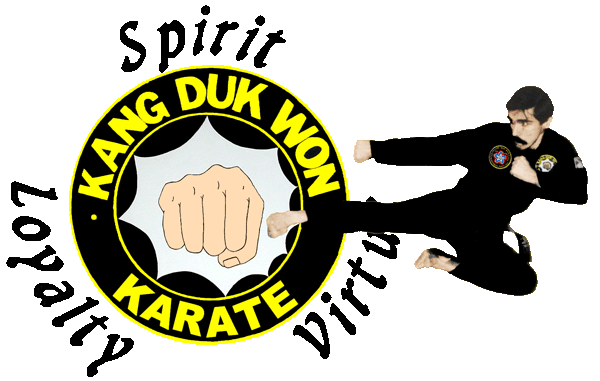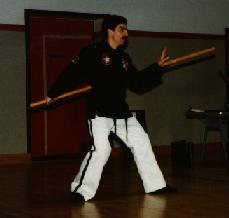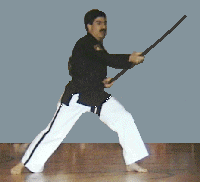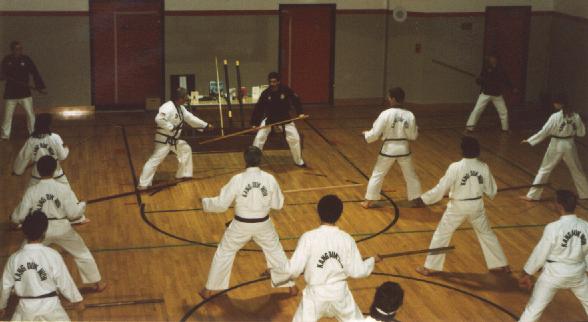 |
AMERICAN KANG DUK WON KARATE |
Sa Kwon: Chinese Bo Kata
More information can be obtained from:
American Kang Duk Won Karate, P.O. Box 151, Watertown, NY 13601
INTRODUCTION TO THE BO
HISTORY AND PHILOSOPHY
Presented By:
Frank A. Palumbo Jr.
Senior Director,
American Kang Duk Won

Rubbings of Bodhidharma from the Peilin Collection of the Shensi
Provincial Museum in Sian, China
The bo, or staff, is one of the earliest tools to be used by man.
Initially it may have been merely a sapling or a long, straight
branch which was used for hunting animals for sources of food
or fur hides. The wooden staff also facilitated passage over rugged
and mountainous terrain. In an agrarian setting it served as a
multi-purpose tool for planting crops, carrying supplies, and
transporting buckets of water for the irrigation of crops.
In the ancient records of Chinese martial arts, the bo is discussed
as the first weapon taught to the Zen Buddhist disciples who studied
at the Shaolin Temple. There are literary and pictorial references
to Bodhidharma carrying a bo on his journeys as he taught Zen
Buddhism in the regions near the Shaolin Temple. One account from
a biography on Bodhidharma tells of his death in 528 AD from the
poison of a jealous monk. It is told that three years later his
body was exhumed due to rumors he had been seen travelling in
the mountains of Central Asia. Bodhidharma was said to carry a
staff from which hung a single sandal. He had stated he was on
his way back to India. When the curious monks opened his tomb,
all they found inside was a single sandal. Ever since then Bodhidharma
has been pictured carrying a staff from which hangs the missing
sandal.
Another historical reference is made to the Zen Buddhist priest
who ordered the disciples of the Shorin-je Temple to perfect and
master bo techniques to help protect their temple. This occurred
at a time of much lawlessness brought about by roving groups of
bandits. This took place while Bodhidharma was the spiritual force
for Zen Buddhism in China. However, no early records mention his
actual teaching of weaponry to his disciples.
Miyamato Mushashi, the great samurai warrior (1584-1645), was
defeated only once and that at the hands of Muso Gonosuke. Gonosuke
had earlier been defeated by Musashi who told the young warrior
to go off and master his long stick techniques before trying again.
Gonosuke's return years later gained Musashi's great respect.
Musashi is said to have then gone intensively into staff, stick,
and kendo training in the later years of his life.
The correct use of the bo (sai, tonfa, kama, naginata, sword)
can produce a stimulating and practical means of "extension"
training. It offers a means of martial arts training and discipline.
Weapons training teaches the meaning of control, timing, distance,
and flexibility as one unit. The practitioner is required to possess
speed, coordination, strength, and endurance in utilizing the
respective weapons.
As in any martial arts training, respect and responsibility are
of utmost importance while inside the training hall and in daily
life. Extension tools are to be treated with the same spirit and
discipline as are the techniques learned in the dojang's regular
workout. The humility and control one exhibits in the martial
arts speak clearly about the lessons a karateka is learning.
ANATOMY AND TYPES OF BO
STANDARD STRAIGHT BO (STAFF)
6' long, 1 1/4" wide;
red or white oak, ash. Length may vary from 4'-8'. This type of
bo is heavy, slow to move, but very powerful. It is quite effective
for smashing or crushing. It was useful for carrying heavy loads
or aided in travels across difficult terrain. In combat an especially
large bo, sometimes made of metal, was used and had blades or
studs added to the surface to assist in the lethal capabilities
of the weapon.
STANDARD TAPERED BO 6' long, 1 1/4" wide and tapers
to 3/4" at ends; oak, ash, hard maple. This type of bo is
light in weight and very well balanced due to its design. The
center is the weapon's fulcrum and allows for quick action. It
has reduced rigidity because of its tapered ends. Blocks and strikes
can be executed with whiplike movement. The smaller ends were
excellent for penetrating armor or flesh in a combat situation.
VARIATIONS OF BO Some weapons were as long as 9' in length
to maximize the advantage a bo offered the warrior--extraordinary
reach.
BAMBOO staffs were sometimes used because of their sharp,
ripping qualities.
YARI (bo with a spear) became popular because they combined
the reach of a bo with the stabbing ability of a sword.
NAGINATA, although not directly related to the traditional
bo, combines the potential for blocking and striking with powerful
ripping capabilities of a larger blade.
JO sticks were shorter walking sticks with greater inside
fighting variations than the long bo.
ESCRIMA fighting sticks are specifically designed as weapons
for striking, blocking, and locking at close range (although still
possessing the extension qualities of the bo).
PROPER CARE OF THE BO
-Proper weight of a Bo will vary according to the stature and
strength of the individual using the tool.
-A Bo should be stored standing straight up or flat on the floor.
The room in which a Bo, or any variation of a Bo, is stored should
be cool and dry for best maintenance. A Bo should not be placed
on pegs or nails and hung from a wall. A tapered Bo should have
both ends resting on a surface of equal height as the center.
-To check for the quality of a Bo's straightness, roll the weapon
on the floor. If it rolls smoothly without making much noise,
it is of good quality and has reliable strength.
BO LITERARY REFERENCES
- Chao, H.C.. Kung Fu Advanced Staff Techniques. Unitrade
Ltd, 1983.
- Demura, Fumio. Bo: Karate Weapon Of Self-Defense. Ohara,
1976.
- Kubota, Takayuki. Weapons Kumite: Fighting With Traditional
Weapons. Unique Publications, 1983.
- Musashi, Miyamato. A Book Of Five Rings. Overlook, 1974.
- Pine, Red The Zen Teaching Of Bodhidharma. North Point
Press, 1989.
- Random, Michel. The Martial Arts. Octopus Press, 1977.
- Un, H.B.. Tong Long (Double End Stick) Kung Fu. H.B.
Un, 1976.
- Wong, James. A Source Book In The Chinese Martial Arts:
History, Philosophy, Systems, and Styles. Koinonia, 1978.
SA KWON: CHINESE BO KATA

N
1-9,17,18,28-31 NW | NE
12-15 | 10b,23-25
. | .
. | .
. | .
. | .
. | .
. ^ .
W -------------------Start------------------ E
11,26,27 . | . 10a,22
. | .
. | .
. | .
. | .
. | .
|
SW | SE
20,21 10c
S
16,19

- Facing North with feet slightly apart, start with the Bo in
left hand, approximately one-third of the way up the Bo.
- Bring feet together and bow. The Bo is at the left side while
the right hand remains open at the right side.
- Keeping feet together, bring the Bo out toward N. Draw
Bo back to left side while also pulling right fist into the chamber.
- Moving forward toward N with the right foot into a low
cat stance, immediately followed by another step toward N
in a left cat stance (left foot forward on ball of foot. Stance
should be slightly lower than a "Basic Form" cat stance).
- Extend the Bo forward toward N from left side with power
and tension. Maintain left cat stance. Bo is perpendicular to
the floor.
- Bring right fist out of chamber slowly with tension next to
Bo at approximately mid-section height.
- Slowly open right hand and turn with palm facing up. Maintain
same left cat stance, right hand remains at mid-section level.
- Draw back into a ready position with feet together. Bring left
leg back to right leg, Bo is simultaneously drawn to left starting
position; right fist goes to chamber.
- Move Bo forward toward N in left hand with tension.
Right hand moves to Bo above left hand. Extend index finger of
right hand upward as Bo is grabbed.
- Look to the right 90 and move left foot out into a horse stance.
At the same time slide the right hand to the top third of the
Bo. Execute a downward block with the Bo parallel to the floor
toward E. Immediately execute a downward block toward NE
(45 forward). Follow with a third downward block toward SE
(45 behind). These three blocks are executed in rapid succession
while remaining in a horse stance.
- Look left (toward W), draw the left leg to the right
into a back stance. This is similar to a cat stance with weight
on the ball of the left foot). Step out toward W executing
an overhead (Sa Kwon) strike to opponent's head or shoulder
level. Keep end of Bo up and lock left elbow next to left leg.
Index finger of right hand should be extended along the Bo - pointing
forward. Strike is completed in a left front stance. (Kihap)
- Draw the Bo along the left side with the left hand moving
back and the right hand sliding to the top third of the Bo. Execute
a low sweeping strike to opponent's knees toward NW (45
forward). This strike is executed in a back stance (70:30 on ball
of the left foot). *From this point this stance will be merely
referred to as a cat stance.
- Follow with an upward strike to the groin by pushing the right
hand down on the end of the Bo and pulling upward on the top third
of the Bo.
- Maintain back stance, draw the Bo with the right hand back
while sliding the left hand to the top third of the Bo with a
reversed grip (left hand turns over the top of the Bo with fingers
closing downward). With the Bo along the left side of the body
for leverage, sweep the Bo across from right to left, striking
to the midsection of the opponent at NW. When the strike
is completed, the left hand is at the end of the Bo and the left
elbow is locked. The technique is completed in a left front stance.
- Drawing the Bo back with the left hand, grab the top of the
Bo with the right hand. Move the left leg in, forming left back
stance (70:30) and execute an overhead strike to opponent's head
or shoulder area. Step out slightly with the left foot during
the strike. (The left arm is forward one third of the way up the
Bo, while the right hand is at the opposite end of the Bo along
the right side-back and just below the right hip. Both arms are
locked).
- Look over the left shoulder to S. Step into a left
back cat stance facing S and execute an overhead (Sa
Kwon) strike completing the technique in a left front stance.
(Kihap)
- Look over the right shoulder to N. Cross the left leg
in front of the right leg moving toward N. At the same
time, bring the Bo straight up and down in front of the body (hands
and Bo are toward W). Switch hands by crossing hands over
at approximately chest level so that the Bo has two-thirds of
its length overhead, yet perpendicular to the floor.
- Complete the cross over step to N in a horse stance
(body faces W, right foot forward in horse stance). Simultaneously
execute a low sweeping motion toward N, followed immediately
by a high sweeping motion again toward N. This strike is
executed with the left hand at the right hip and the right hand
forward on the Bo. The right elbow is bent on the inside of the
Bo. (Establish this position as the hands complete the grip "crossover"
and while the horse stance is being formed. The elbow and outer
forearm are used for leverage and power during the low strike
- to the knees, high strike - to the head. The strike is a 180
arch-low/high).
- Look to S, pulling the Bo at chest level to generate
motion,jump and spin toward S completing a 360 turn counter-clockwise.
Execute an overhead strike in a left front stance.
- Look and move toward SW in a right cat stance executing
a low outside block. (This is a short block against an attack
to the legs). Follow immediately with a circular downward block.
(This technique counters the attack by turning the attacker's
weapon away from the legs. The technique is a short pushing movement
at knee level in a counter-clockwise motion).
- Move forward toward SW and execute a mid-section thrusting
strike in a right front stance (right arm forward).
- Look and move toward E crossing the right leg in front
of the left. Execute and upward strike to opponent's chin. (Push
up with the left hand while pulling down on the end of the Bo
at shoulder level). Strike is completed in a crossed stance, legs
slightly bent.
- Slide the left hand forward to the end of the Bo, move to
NE and execute a low downward block. Follow immediately
with an upward circular strike to opponent's head. This sequence
is completed in a left front stance; left hand at the side just
below hip and right hand forward two-thirds of the way up the
Bo.
- Move the right foot forward forming a cat stance. Toward NE
execute a low short circular pushing block against and attack
to the leg. This block is executed in a counter-clockwise motion,
starting approximately a half foot from the floor and completed
about one and a half to two feet - pushing an attacking Bo down
and away.
- Follow immediately with a right front stance thrusting strike
to an opponent's mid-section toward NE, (This is the same
as in movement #20-21).
- Draw Bo back over right shoulder while looking left to W
forming a left cat stance. Step out into a left front stance to
W executing an overhead (Sa Kwon) strike with left
hand at the end of the Bo just below left hip. The right hand
is out in front of body, two-thirds of the way up the Bo.
- Draw the Bo back along the left side of body. Slide the right
hand to the top of the Bo. While looking W swing the Bo
with full power in a clockwise motion 350 . (The Bo travels behind
the back and is controlled solely by the right hand. As the swinging
technique is executed move into a left back stance). The left
hand executes a knife-hand block and stops the circular path of
the Bo. The knife-hand block should be slightly behind the body
so that the Bo does not strike the body at the completion of the
swinging technique.
- Grab the top of the Bo with the left hand. Turn 90 toward
N in a left cat stance. (The Bo will be resting on the
left shoulder; release the right hand from the Bo). Bo is parallel
to the floor.
- Bring the right fist forward toward N along side of
the Bo slowly. Open the right hand with fingers together pointing
forward.
- Slowly draw back into a ready stance moving the left leg back
to the right. The Bo moves from the left shoulder to the left
side with the left hand at the bottom third of the Bo. The Bo
is perpendicular to the floor as at the beginning of the form.
The right hand comes to the side of the right leg; feet together
facing N.
- Bow.
 Master Palumbo instructing a bo seminar at the main dojang
in Watertown, NY
Master Palumbo instructing a bo seminar at the main dojang
in Watertown, NY
Return to Traditional Martial Arts Weapons

Return to the American Kang Duk Won Karate Homepage
Copyright © 1999-2007 American Kang Duk Won Karate






